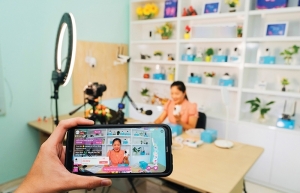Livestreaming rise presents disruption to commerce
At its AGM on June 19, food producer KIDO Group highlighted the role of livestreaming in its business strategy. Its Entertainment to E-Commerce trade promotion project on TikTok will remain a valuable tool for the group to execute marketing strategies, promote products, and test new markets while understanding consumer behaviour better, especially through livestreaming.
“Previously, KIDO sold goods via traditional channels. Since the project was launched late last year, we have taken the advantage of livestreaming to launch new products. The more livestreams we carry out, the more orders we are likely to close,” said CEO Tran Le Nguyen.
KIDO’s platform offers a blend of shopping, entertainment, and promotional activities, and brands under KIDO have actively participated in livestream sales events to enhance brand visibility and boost revenues.
 |
| Livestreaming rise presents disruption to commerce, illustration photo/ Source: freepik.com |
Likewise, consumer electronics chain FPT Shop has also jumped on the bandwagon to promote its products via livestreaming on TikTok. The move aims to tap into the growing shoppertainment trend and changing consumer behaviours in Vietnam’s e-commerce industry.
Vietnamese coffee brand Meet More is also promoting its livestream sales strategy in 2024 with a goal to boost 10-20 per cent of revenue from omnichannel sales. Livestreaming currently makes up for half of Meet More’s revenue.
Ralf Matthaes, managing director of IFM Research, told VIR, “Livestreaming is still in its infancy in Vietnam, so there is still a lot of room to grow. Furthermore, younger people seem to have shorter attention spans and prefer videos to reading. Hence, this format of advertising has already taken hold for this generation, both in terms of careers and purchase channels.”
As an example, 43 per cent of all online consumers have purchased at least once in the past 30 days on TikTok Shop, showing how livestreaming sales are taking hold in Vietnam.
“Brands are looking for any advantage they can find at present. So livestreaming shall increase in frequency, and more and more brands will join the fray,” Matthaes added.
With a high internet penetration, Vietnam is a fertile land for livestreaming. NielsenIQ, a global measurement and data analytics company, revealed a survey in April showing that about 95 per cent of online shoppers likely purchased items from livestream sales sessions in the first quarter of 2024. Vietnamese spend 13 hours per week watching livestream sales sessions on average.
“Customers are attracted to livestreams due to the entertainment factor, the convenient interaction with sellers to get more information, and the detailed and throughout observation of the products. A remarkable 64 per cent of livestream viewers are motivated to make more impulsive purchases than usual. Meanwhile, up to 78 per cent of customers said they feel excited when watching the sessions,” NielsenIQ noted.
According to AccessTrade Vietnam, the three most popular livestream platforms in Vietnam are Facebook (31.9 per cent), Shopee (30.9 per cent), and TikTok (17.2 per cent). On average, there are 2.5 million livestream sales sessions each month, with the participation of more than 50,000 sellers.
Peter Christou, general manager of the Vietnam Worldpanel Division at Kantar, said in just the last two years, the rise of livestreaming commerce in Vietnam has presented a fascinating disruption to fast-moving consumer goods (FMCG) sales strategies.
“We see this trend, specifically brand and content, as an opportunity for companies to connect with consumers in a more engaging and interactive way. To thrive in this new landscape, companies need to adapt their strategies by focusing on two key areas: understanding the evolving consumer journey and developing effective channel and portfolio strategies,” Christou said.
Social commerce, and particularly livestreaming platforms, are transforming the way consumers discover and purchase FMCG products, Christou added. “It is no longer a linear journey from awareness to purchase. Livestreaming serves as a focal point of conversion, influencing both the upstream and discovery phase where consumers become aware of products, and the downstream decision-making process where they decide to buy.”
As the rise of livestreaming does not negate other retail channels, Christou advised brands to develop both complementary channel and portfolio strategies that cater to different shopper groups across various channels.
Matthaes from IFM Research noted that, like any form of advertising, it is essential to understand three critical marketing performance indicators: livestream awareness, reaching the correct target audience, and improving content and products.
“At present, livestreaming costs are heavily reliant on key opinion leaders and discount volumes. This is not a recipe for success, and brands may erode their own image and kill their market share in other retail channels,” Matthaes said.
“Hence, the most important lesson to learn now is to ensure brands use the right advertising spending. Another strategy is to mix and limit discounts to avoid over-reliance on livestreaming, which may ultimately reduce margins and erode a brand’s image,” he added.
 | Livestream commerce booms Livestreaming jobs are forecast to boom this year as the pandemic continues to stimulate the demand for online shopping. However, the trend is also putting the government on edge as it seeks suitable management modes. |
What the stars mean:
★ Poor ★ ★ Promising ★★★ Good ★★★★ Very good ★★★★★ Exceptional
 Tag:
Tag:
Related Contents
Latest News
More News
- Global partnerships key to Vietnam’s IFC development (December 26, 2025 | 16:18)
- Vingroup pulls out of bid to invest in North-South high-speed railway (December 26, 2025 | 11:42)
- Strengthening supply chains through trade promotions and customs reform (December 24, 2025 | 14:00)
- PM orders investment model for North–South high-speed rail (December 22, 2025 | 17:43)
- LS Eco Energy to invest in Vietnam rare earth sector (December 22, 2025 | 17:31)
- Government moves to establish International Financial Centre (December 21, 2025 | 21:00)
- Vietnam's IFC to target global investment flows (December 21, 2025 | 18:00)
- Two national hospitals expand capacity with new facilities (December 20, 2025 | 09:00)
- Ha Tinh breaks ground on major Vingroup industrial and energy projects (December 19, 2025 | 18:24)
- EVN launches major power infrastructure projects nationwide (December 19, 2025 | 18:17)























 Mobile Version
Mobile Version